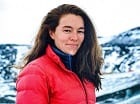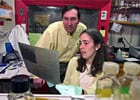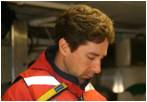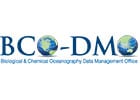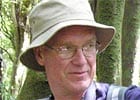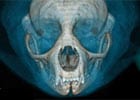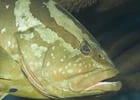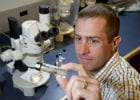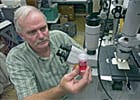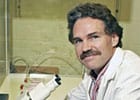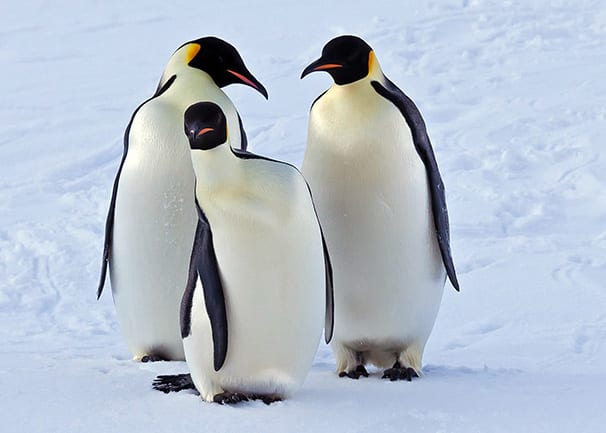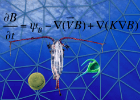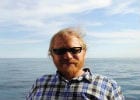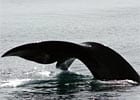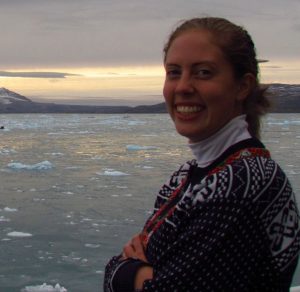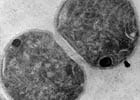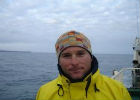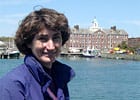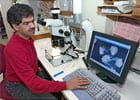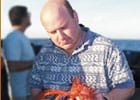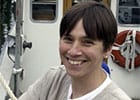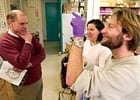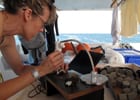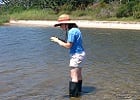Biology Labs
Alexander Lab
Our lab focuses on the application of computational approaches to oceanographic questions. We use a combination of culture- and field-based studies to better understand the biogeochemical functioning and physiological ecology of eukaryotic plankton in a changing ocean. Topics of interest include the maintenance of genetic diversity in planktonic populations and the role of biodiversity in ecosystem functioning.
Aluru Lab
Research in our lab is mainly focused in understanding the mechanisms by which exposure to environmental chemicals and other stressors affect human and animal health. Our interest is mainly in investigating the epigenetic mechanisms particularly DNA methylation.
Anderson Lab
The overall focus of research in the Anderson laboratory is on toxic or harmful algae—the species responsible for the phenomena commonly called “red tides” or “harmful algal blooms (HABs)”. Our work spans the spectrum from mesoscale investigations of algal bloom dynamics to studies at the cellular and molecular levels. A strong focus is on the use of novel instruments to investigate algal blooms in situ using optical and molecular technologies.
Ashjian Lab
My research focuses on a variety of problems in biological oceanography and zooplankton ecology and particularly on how physical and biological processes together define zooplankton biogeography, structuring of zooplankton communities and populations, zooplankton population abundance, and the transformation of organic material.
Baumgartner Lab
My research interests focus primarily on top predator ecology and the physical and biological oceanographic processes that allow those predators to survive in the ocean. I am particularly interested in using baleen whales and their zooplankton prey as a tractable system in which questions can be addressed about how prey behavior, life history, and aggregation mechanisms can influence top predator distribution and behavior.
Biological and Chemical Oceanography Data Management Office (BCO-DMO)
Principal Investigators: Peter Wiebe, Danie Kinkade, Mak Saito, and Adam Shepherd
BCO-DMO serves investigators funded by the NSF Geosciences Directorate (GEO) Division of Ocean Sciences (OCE) Biological and Chemical Oceanography Sections and Office of Polar Programs (OPP). BCO-DMO manages and provides access to oceanographic biogeochemical, ecological, and complementary physical data and information generated through scientific research funded by these NSF programs. Contact: info@bco-dmo.org
Britten Lab
Gregory Britten and the Population and Ecosystem Modeling Lab work to quantify the structure and dynamics of marine ecological systems. We do basic and applied modeling, seeking to understand how systems work while contributing to science-based decision making, particularly in the context of climate and oceanographic change.
Caswell Lab
I study the mathematical ecology of populations and communities. I use models that include the life cycle, the vital rates, dispersal patterns, and temporal and spatial variation in the environment to explore population growth, extinction, invasion, and spatial pattern, and apply the results to conservation biology.
Computerized Scanning and Imaging Facility (CSI)
CSI, equipped with a research dedicated high resolution medical scanner and imaging area, large animal lift and overhead rail transport system, specially designed laboratories, freezers, and chillers for dissection, and necropsy and specimen storage, offers researchers an opportunity to conduct multiple exams in a single setting.
Edgcomb Laboratory (Geology & Geophysics Department)
The Edgcomb laboratory studies how oxygen-depleted and anoxic marine environments shape microbial communities, their genomic potential, metabolic activities, and interactions, particularly with protists.
Fish Ecology Lab
We study fish movements in the ocean and the links between food web dynamics and the resilience of coral reefs. Our goal is to provide decision makers with a scientific basis for the conservation and sustainable management of ocean ecosystems.
Fisheries Oceanography and Larval Fish Ecology Lab
Our research is generally focused on how fish and fish larvae interact with their environment, particularly what they feed on and how well they are feeding, as well as what environmental factors influence these two variables.
Gallager Lab
My research focuses on the functional morphology and biophysics of locomotion and feeding in microplankton, meroplankton, holoplankton, and icthyoplankton including understanding the importance of early life history stages in recruitment success in fishes, and optimizing culture techniques of microbial communities, particularly microplankton. Development of instrumentation for quantifying the micro-scale to meso-scale distributions and the physical environment of plankton is central to my research objectives.
Hahn Lab
A focus of the laboratory is to understand the biochemical and molecular mechanisms that underlie the interactions of marine animals with their chemical environment.
Jenouvrier Lab
Our group studies the effects of global change on individuals and populations of a community of seabirds breeding in the Southern Ocean. Specific areas of interest include how climate changes and human activities affect the behaviors (e.g. foraging) and vital rates of individuals (e.g. survival and breeding success); the timing of key life cycle events (e.g. breeding phenology); and the population growth and structure.
Ji Lab
We use numerical-modeling and data-analysis approaches to study biological-physical interactions in the ocean. Special interests include plankton phenology and biogeography, food-web dynamics, population dynamics and connectivity, and polar-ecosystem dynamics.
Kellner Lab
Our primary research interests include theoretical and spatial ecology with an emphasis on understanding the dynamics, management, and conservation of aquatic ecosystems.
Laney Lab
The Laney lab explores the photosynthetic ecology of marine phytoplankton, primarily through autonomous observing and field studies. Such research relies heavily on the development of new instrumentation and sensors, with an emphasis on bio-optical methods. A particular area of interest is polar oceans, especially the Arctic, where such technological advances help us overcome historical challenges with sampling and observing photosynthesis in the ocean.
Marine Mammal Behavior Laboratory
Research focuses on social behavior and acoustic communication in cetaceans, playback to cetaceans of their own and conspecific vocalizations, responses of cetaceans to manmade noise, and vocal learning, mimicry in the individually distinctive signature signals of bottlenose dolphin and the group distinctive click patterns of sperm whales, acoustic structure and social functions of the songs of baleen whales, and functional studies of echolocation in free-ranging cetaceans.
Microbial Biogeochemistry Group at WHOI
Principal Investigators: Joan M. Bernhard, Karen Casciotti, Marco J.L. Coolen, Elizabeth B. Kujawinski, Carl H. Lamborg, Dennis J. McGillicuddy, Daniel J. Repeta, Mak Saito, Stefan Sievert, Benjamin van Mooy, John B. Waterbury
Scientists in the microbial biogeochemistry group at WHOI are studying microbes and microbial processes in environments as different as boiling hot deep sea hydrothermal vents and subzero arctic permafrost. Our research draws from biology, chemistry, and geology to explore how microbial processes are altering today’s world, and to look into the past to the very origin of life in the sea.
Mooney Lab
We address sensory biology: how animals detect and respond to the signals and cues around them. With a focus on bioacoustics, we often address questions related to hearing and sound production (basic research), but also quantify sensory ecology to evaluate how changing environments (often due to human influences) may impact sensory processes. We use tools in physiology, behavior and ocean observation.
Moore Lab
As a veterinary scientist Michael Moore has a broad interest in the fundamental and applied aspects of the interface between humans and marine animals. Research in his group includes: the pathology of human derived marine mammal trauma - vessel, fishing gear and acoustic; animal welfare consequences of such trauma; large whale body condition and the population consequences of fluctuations therein; marine mammal stranding management; impacts of tracking tags on cetaceans; and long term effects of persistent pollutants on bottom fish in the context of environmental remediation.
Mullineaux Benthic Ecology Lab
The Mullineaux Lab studies the dispersal of larvae of benthic invertebrates through the ocean, their settlement back to the seafloor, and the influence of these processes on resilience of benthic communities. We use field observations and laboratory experiments to understand how larvae respond to environmental cues, and mathematical models to understand connectivity and dynamics of geographically separated communities. Our field sites range from coastal bays in New England to deep-sea hydrothermal vents in the eastern and western Pacific.
Neubert Lab
The members of the Neubert Lab construct and analyze mathematical models to address a wide variety of topics in ecology, conservation biology, and renewable resource management.
Olson Lab
Research interests in the Olson lab include plankton ecology, studied through the distributions of individual organisms; potential of flow cytometric technology to characterize the microscopic particles in the sea.
Pineda Lab
We study the processes that determine the fluctuations of coastal marine organisms at a variety of temporal scales, and why they can be more abundant at certain sites. One theme is to resolve mechanistically the biological and physical processes associated with the larval transport and dispersal of coastal invertebrate species, their settlement, and recruitment. Another aim is to understand how bathymetry and short-term variability in currents affect the aggregation of fish, sharks and marine mammals.
Sato Lab
My research focuses on biological-physical interactions, addressing how environment influences animal behavior and distributions in coastal ecosystems and how those interactions affect trophic dynamics including zooplankton, fish, and marine mammals. In order to address problems across a range of temporal/spatial scales, I use active acoustics in different platforms (vessels, moorings, cabled observatories) combined with net sampling and physical measurements.
Shank Lab
The research interests of the Shank lab are focused on understanding the ecological and evolutionary processes that structure genetic diversity and function in benthic marine species.
Shero Lab
How is an animal expected to be able to “make a living” in an ever-changing environment? – and why are some animals more successful, that is, survive and reproduce more than others? These are the types of questions we seek to answer in the lab. The Shero Lab focuses on the linkages between energy balance and physiological condition, behavior, and reproductive success of marine mammals.
Sievert Lab
The Sievert Microbial Ecology & Physiology Lab studies the composition and function of microbial communities, with the goal to understand the relationship between microorganisms and their biogeochemical transformations. Special interests include chemosynthetic processes that are important in a variety of environments, including hydrothermal systems, oxygen minimum zones, and sulfidic marine sediments.
Sosik Lab
The main research interests of the lab include: Phytoplankton ecology and photophysiology; bio-optical oceanography; modeling of marine primary production; physical forcing and regulation of phytoplankton biomass and production; fluorescence-based assays for photosynthetic properties; relationships between phytoplankton and water column optical properties; scaling from single cells to global systems.
Stegeman Lab
Broadly, our passion is to understand the mechanisms and significance of chemical effects in animals in the sea. Specifically, we focus on genes and enzymes and receptors involved in responses to chemicals, and how these same genes and proteins may participate in physiological processes. Studies currently address chemical effects in the brain and on behavior, and use directed mutation to selectively render specific genes non-functional, to assess their role in effects.
Tarrant Lab
We study how invertebrate animals detect and respond to signals and stresses in the marine environment. Much of our research is focused on the sea anemone Nematostella, which we are using to study evolutionary and ecological questions about circadian rhythms, nuclear receptor signaling, physiological acclimation, redox physiology, and responses to chemical pollutants. Our second focus is on the physiology of Calanus copepods as related to development, diapause and energetics.
Tepolt Lab
We focus on ecological genomics, combining molecular tools with ecological fieldwork and physiological experiments to shed light on the processes that shape species' current and potential ranges. Our primary area of interest is in using marine species invasions as natural experiments in rapid adaptation, examining how – and how quickly – populations respond to novel conditions.

